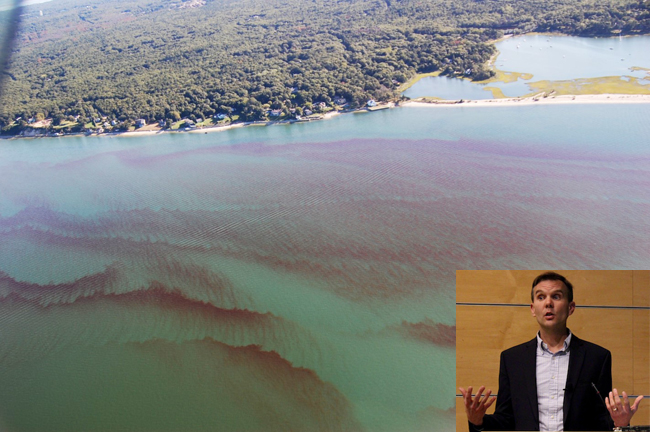
"This has been one of the worst years for brown tide and red tides that cause paralytical shellfish poisoning," said researcher Christopher Gobler (pictured above, in inset, at April's State of the Bays talk) in late July. "Conversely, blue-green algal blooms have been mild thus far." Above, a rust tide is seen in Long Island's Peconic Estuary. Credit: Auxiliary Coast Guard; (insert) The Peconic Bathtub.
— By Chris Gonzales, Communications Specialist, New York Sea Grant
Stony Brook, NY, August 14, 2017—The first thing most people notice is the mysterious, unusual color in the water: red, brown, green, or sometimes blue-green. However, the colorful displays disrupt marine habitats, as blooms can be a nuisance or foster damage in ecosystems. Algae can also harm the family dog, or cause illness or even death in humans.
While the color gives rise to common names such as red tide or brown tide, scientists and government officials use the technical term “HABs” to denote several types of “harmful algal blooms,” which are defined as conditions when a subset of algal species—tiny aquatic plants—produce toxins or grow excessively, harming humans, other animals and the environment.
As murky, algae-filled water washes up on Long Island’s coastlines, several major types of threats could be present. One class of HABs is harmful to marine life. This includes the microscopic alga Aureococcus anophagefferens, which may bloom in such densities that the water turns dark brown, a condition known as “brown tide.” Brown tides are known for blocking light, knocking down the eel grass that fish and shellfish rely on for habitat.
Another group of HABs on Long Island can cause illnesses if people consume shellfish that have been feeding in the affected area. The most common of these HABs is the dinoflagellate Alexandrium. Some symptoms can range from nausea, vomiting, diarrhea and cramps. In severe cases, people can be afflicted with dizziness, headache, seizures, disorientation, short-term memory loss, respiratory difficulty and even coma.
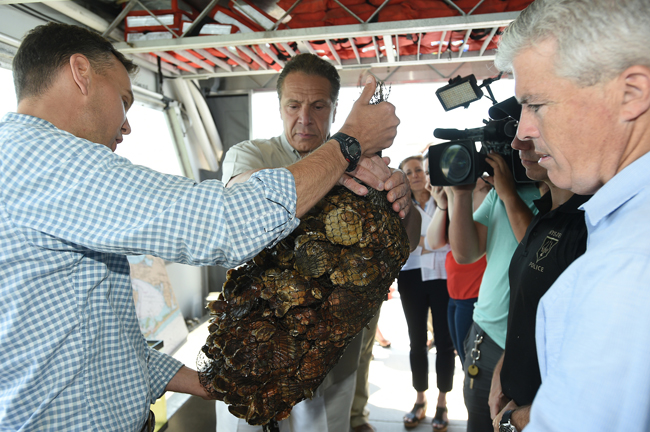
Stony Brook University School of Marine and Atmospheric Sciences investigator Christopher Gobler (at far left) is studying the impact that seeding clams and oysters as well as seaweed aquaculture has on reducing levels of nitrogen in Long Island’s bays, which could lessen the occurrence of brown tide blooms. He is discussing these concepts at a early June 2017 press conference at Stony Brook Southampton with (l-r) Governor Andrew M. Cuomo and Suffolk County Executive Steve Bellone. Photo: Office of the Governor / Kevin P. Coughlin/Office of Governor Andrew M. Cuomo.
Worldwide Issue, Local Plan
While the water spoilers are a global problem, they may be more significant in the Long Island Bays than anywhere else in the United States in terms of the size of the population and industry affected. The problem spans both fresh and salt water systems.
Records of these water-borne, illness-causing organisms date to the 1930s, but the problem is increasing in frequency and intensity.
“This [2017] has been one of the worst years for brown tide and red tides that cause paralytical shellfish poisoning,” said Dr. Christopher Gobler, Associate Dean for Research and a professor at Stony Brook University’s (SBU) School of Marine and Atmospheric Sciences (SoMAS). “Conversely, blue-green algal blooms have been mild thus far.”
William Wise, Director of the New York Sea
Grant (NYSG) program, has been preparing a HABs Action Plan for Suffolk
County, a year-plus-long effort for which results are slated for release
this fall.
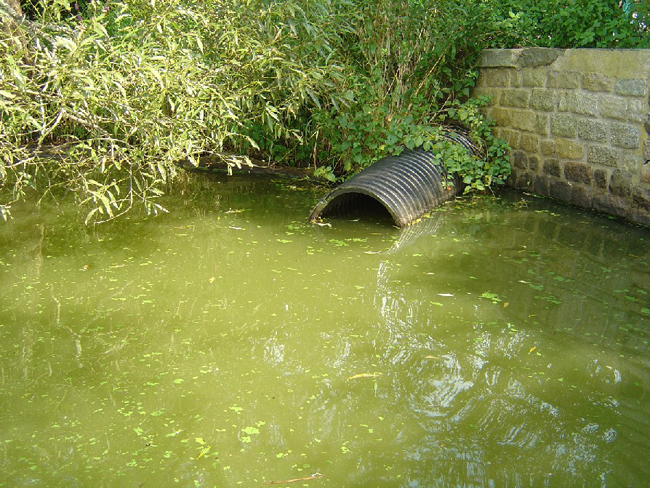
Due to their depth, shallow water bodies such as Southampton's Lake Agawam (pictured above and below) and East Hampton's Georgica Pond are often more vulnerable to nutrient overloading, and thus harmful algal blooms. Photo: Chris Gobler.
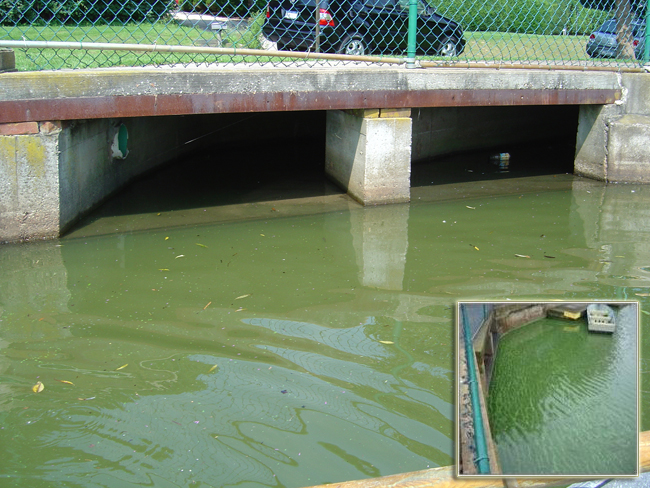
Key Personnel
Too much nitrogen—and sometimes too much phosphorous—is the primary
cause of these events, although some HABs can be problematic without a
surplus of those nutrients. In an effort to help reduce the severity of HABs—or at least limit their
negative effects, especially those concerning public health—NYSG
entered into an agreement last year with Suffolk County Department of
Health Services to prepare an Action Plan.
The plan is expected to lay out a
strategy for monitoring, research, and management. It will include
possible proposals for limiting nitrogen, such as: upgrading septic
systems; deploying seaweed farms and shellfish aquaculture facilities;
and routine monitoring for toxins.
Gobler, who has received support from NYSG for nearly two decades, has also partnered with the program to raise awareness about the problems HABs pose. Early this past April, he gave his annual “State of the Bays” address on SBU’s Southampton campus. Highlights from Gobler’s presentation—which were first offered a few days later by writer Beth Young for The Peconic Bathtub—are summarized below.
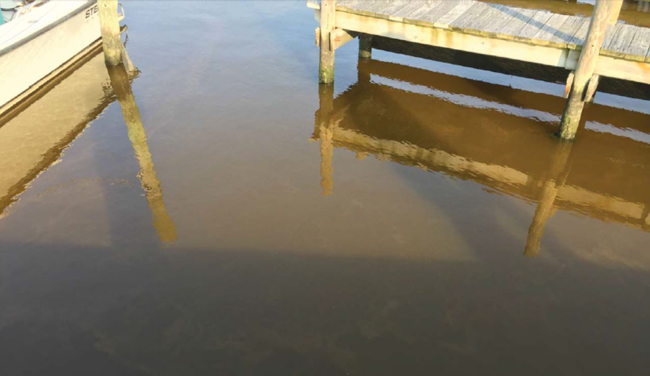
Poor residence time, a measure of how long it takes for water to flush out of the bay and into the ocean, in places like Hempstead Harbor on Long Island's North Shore in Nassau County can lead to higher concentrations of nutrients and therefore a a proliferation of harmful algal blooms such as the magogany tide seen here. Photo: Theresa Hattenrath.
Gobler says there are some things that could help improve water quality conditions, such as scientists heeding to U.S. Environmental Protection Agency guidance on the roles played by both nitrogen and phosphorous entering waterways—both of which contribute to harmful algal blooms.
In his presentation, Gobler spoke about the need to reduce the amount of nitrogen entering the islands waterways, due largely to the lack of advanced sewage treatment in Suffolk County. Suffolk County revised its sanitary codes in 2016 to promote individual on-site advanced nitrogen-reducing septic systems, which Gobler believes is a major step forward in protecting water quality.
What's Fueling Harmful Algal Blooms in Long Island's Waters? To get a better picture of the causes of harmful algal blooms in our local waterways, researcher Chris Gobler offers a comprehensive explanation of some of the prime contributors to harmful algal blooms, at least in the bays of Long Island, NY. He is seen above in an extended 2013 interview with News 12, a local television station with bases on Long Island, Connecticut and New Jersey. In this eight-and-a-half-minute Q&A, Gobler discusses, among other things, how groundwater contaminants affect local waterways.
Scientists Gather
NYSG also recently hosted an expert session on the HABs at SBU SoMAS. Among the main points: Harmful algal blooms are fairly well studied; we know much about their severity, frequency, variety, toxicity and geographic distribution. Important sources of nitrogen on Long Island include septic systems and cesspools, agricultural runoff and residential fertilizers. Each HAB occurring in Long Island’s waters is affected differently by excessive nitrogen.
Experts are examining techniques that could improve water conditions—such as upgrades to septic systems, agricultural practices, wastewater treatment methods—as well as continued monitoring and modeling.
As summer got underway and people began heading back to the beaches, scientists were working to keep people safe by monitoring for and managing effects of harmful algal blooms. Gobler regularly gathers much of this survey information via the Facebook page for his Long Island Coastal Conservation Research Alliance (LICCRA).
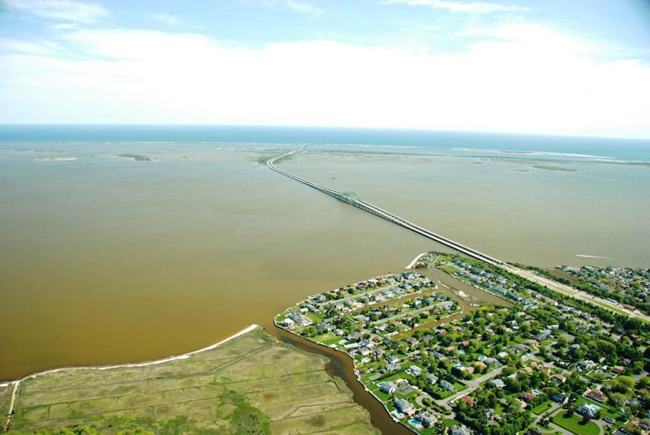
As reported by Gobler on LICCRA's Facebook page, August 1st marked the end of one of the longest and most intense brown tides on Long Island on record (10 weeks). "What began at an ominously early time (early May) and in a strangely uncommon place (South Oyster Bay), spread to cover the entire south shore of Long Island by early June and persisted in Great South Bay [pictured above; Photo: Suffolk County Department of Health Services] through late July, marking one of the longest brown tide on record. It was the most intense brown tide ever, reaching peak intensity of 2.3 million cells per milliliter in Bay Shore in early July."
As for what this could mean for the overall ecosystem, Gobler added, "Such extended events are known to lead to mass mortality in seagrass and clams and the timing of this event overlapped when most bivalves were reproducing; such early life stages are highly vulnerable to brown tide. In other ecosystems, brown tides have also been shown to have ecosystem-wide effects, including fish and marine mammal moralities. Time will reveal the effects this record-setting event has had on Long Island ecosystems.
And what could help curtail episodes like this moving forward? "Efforts to stem the delivery of nitrogen to Long Island's south shore in the future will help prevent the recurrence of these events," says Gobler
On Air: In-Depth—Harmful Algal Blooms
In a early-May 2017 segment that aired on WSHU FM, NPR's local affiliate station on Long Island and Connecticut, SBU's Chris Gobler said that humans who eat shellfish contaminated by the toxic blooms could face sickness or, in severe cases, death. “That’s the big thing, this is a human health concern, and so if the blooms are getting more intense or occurring in new places, then you suddenly have a new or expanding human health threat.”
AUDIO: "Stony Brook Scientists: Toxic Algal Blooms Linked To Ocean Warming" (WSHU FM, May 1, 2017)
Note: If you don't see the player above, it's because you're using a non-Flash device (eg, iPhone or iPad).
And in early July 2016, WSHU FM released a brief audio segment (about a minute-and-a-half in length) that also helps to clarify the causes and severity of different harmful algal blooms.
AUDIO: "Explaining Those Harmful, Even Deadly, Algal Blooms" (WSHU FM, July 1, 2016)
Note: If you don't see the player above, it's because you're using a non-Flash device (eg, iPhone or iPad).
More Info: New York Sea Grant
New York Sea Grant (NYSG), a cooperative program of Cornell University
and the State University of New York, is one of 33 university-based
programs under the National Sea Grant College Program (NSGCP) of the
National Oceanic and Atmospheric Administration (NOAA). The NSGCP
engages this network of the nation’s top universities in conducting
scientific research, education, training and extension projects designed
to foster science-based decisions about the use and conservation of our
aquatic resources. Through its statewide network of integrated
services, NYSG has been promoting coastal vitality, environmental
sustainability, and citizen awareness about the State’s marine and Great
Lakes resources since 1971.
New York Sea Grant maintains Great Lakes offices at SUNY Buffalo, the
Wayne County Cooperative Extension office in Newark and at SUNY Oswego.
In the State's marine waters, NYSG has offices at Stony Brook University
and Stony Brook Manhattan, in the Hudson Valley through Cooperative
Extension in Kingston and at Brooklyn College.
For updates on Sea Grant activities:
www.nyseagrant.org has RSS,
Facebook,
Twitter, and
YouTube links. NYSG produces a monthly e-newsletter, "
NOAA Sea Grant's Social Media Review," via its blog,
www.nyseagrant.org/blog. Our program also offers a free e-list sign up via
www.nyseagrant.org/coastlines for its flagship publication,
NY Coastlines/Currents, which is published 1-2 times a year.